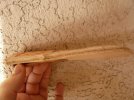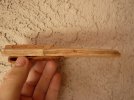quoted for relevant content.

Something as small as a knife sheath should suffer relatively little from the stretch described by Dwayne (Leatherman).
Paul
I wasn't referring to stretch in reference to the twist of the sheath, it was just illustrating the point about leather grain.
Take corrugated cardboard for example. Fold it in line with the corrugations and its easily done, fold it in a diagonal and it wants to twist. When I cut a folded sheath out of line with the grain I get a sheath that doesn't want to fold straight, when cut in line it folds straight and easy. I did this experiment with the last 100 sheath order I did that had 7/8oz leather (small edc sheaths) and it was very consistent. And irritating.

Forcing a few dozen sheaths to your will can wear on the patience.
A couple of years ago, under great pressure to produce a better product, Tandy/Leather Factory went on the search for a better tannery. The result of that is quite nice. For the most part I use Double Bends, and #1 grade Double Shoulders, almost no waste. The new tannage is light years better, nice touch, smooth face, very good flexibility, no hard spots and fewer if any scars and bug bites. I like being able to dig through the stacks at the Leather Factory and find what I want. Lately the only disappointment has been when they run out of a particular type. If I get something home and am not happy with it, I can return it and get a replacement immediately.
This leather has been torture tested in some of the worst environments, much to my chagrin

and the leather has come through with flying colors. Just dont go cheap, pick through the piles, and you wont be disappointed



